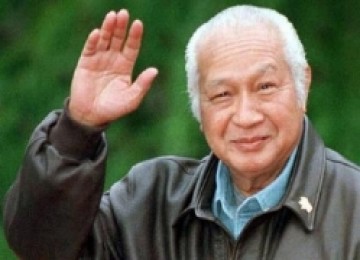Suharto, (born June 8, 1921, Kemusu Argamulja, Java, Dutch East Indies [now Indonesia]—died Jan. 27, 2008, Jakarta, Indon.), army officer and political leader who was president of Indonesia from 1967 to 1998. His three decades of uninterrupted rule gave Indonesia much-needed political stability and sustained economic growth, but his authoritarian regime finally fell victim to an economic downturn and its own internal corruption.

Like many Javanese, Suharto used only his given name, without a surname. The son of a minor official and trader in Yogyakarta, he aspired from his youth to a career in the military. After graduating from high school and working briefly as a bank clerk, he joined the Dutch colonial army and then, after the Japanese conquest in 1942, switched to a Japanese-sponsored home defense corps, receiving training as an officer. With Japan’s surrender in 1945, he fought in the guerrilla forces seeking independence from the Dutch. By the time Indonesia became a republic in 1950, Suharto had distinguished himself as a battalion commander in central Java and achieved the rank of lieutenant colonel. Over the next 15 years he rose steadily through the ranks of the Indonesian army, becoming a colonel in 1957, a brigadier general in 1960, and a major general in 1962.

In 1963 Suharto was routinely appointed to head the army strategic command, a Jakarta-based force used to respond to national emergencies. Indonesia’s leader, President Sukarno, had meanwhile cultivated close ties with the Indonesian Communist Party (PKI) and with China, but the army had remained strongly anticommunist. On September 30, 1965, a group of disgruntled left-wing army officers and some PKI leaders tried to seize power in Jakarta, killing six of the army’s seven senior generals. Suharto was one of the highest-ranking officers to escape assassination, and, as head of the strategic command, he led the army in crushing the coup within a few days. Sukarno was suspected of complicity in the coup, and power now began to shift to the army. In the following months, Suharto directed a purge of communists and leftists in public life, and his example was followed in exaggerated form by vigilantes in a grand massacre of communists throughout the country in which hundreds of thousands lost their lives.
Suharto, by now army chief of staff, took effective control of the Indonesian government on March 12, 1966, though Sukarno remained nominal president for another year. Suharto banned the PKI and began formulating new policies to stabilize the country’s economy and political life, which had approached the brink of chaos in the last years of Sukarno’s rule. In March 1967 the People’s Consultative Assembly (the national legislature) appointed Suharto acting president, and in March 1968 it elected him to a five-year term as president.

As president, Suharto instituted a policy he called the New Order, relying on the help of American-educated economists to reinvigorate the Indonesian economy. Western investment and foreign aid were encouraged, and Indonesia’s domestic oil production was greatly expanded, with the resulting revenues used to fund infrastructure and development projects. By 1972 Suharto had succeeded in restoring steady economic growth while also reducing the annual rate of inflation from a high of 630 percent in 1966 to less than 9 percent. In foreign affairs, he pursued an anticommunist, pro-Western stance. Indonesia rejoined the United Nations (from which Sukarno had withdrawn it), and in 1967 it became a founding member of the Association of Southeast Asian Nations (ASEAN). In 1976 Indonesia forcibly annexed the Portuguese colony of East Timor despite widespread international disapproval.

Though he was careful to follow constitutional forms, Suharto’s government was basically an authoritarian regime based on the power of the military, which insinuated itself deeply into every branch of the government and the economy. As head of the armed forces and the government, Suharto maintained complete control of the country’s political life. His government-sponsored political party, Golkar, repeatedly scored landslide victories in elections to the People’s Consultative Assembly, and that body in turn reelected Suharto unopposed to the presidency in 1973, 1978, 1983, 1988, 1993, and 1998. Civil liberties were restricted, and little dissent was tolerated.
During Suharto’s three decades in power, Indonesia’s economy grew an average of 7 percent annually, and living standards rose substantially for the bulk of the population. Education and mass literacy programs were used to propagate the national language, Bahasa Indonesia, and to unify the country’s disparate ethnic groups and scattered islands. The government also initiated one of Asia’s most successful family-planning programs in order to slow down the growth of Indonesia’s large population. These successes were increasingly marred, however, by the inequitable distribution of the nation’s expanding wealth, with relatively small urban elites and military circles receiving a disproportionately large share of the benefits of modernization and development. Suharto allowed his friends and his six children to assume control of key sectors of the economy and amass enormous fortunes by means of monopolies and lucrative trade arrangements.

By the 1990s the unrestrained corruption and favoritism of his regime had begun to alienate even the middle class and business circles, but continuing high rates of economic growth and the government’s tight political controls insulated Suharto from any genuine opposition. In 1997, however, Indonesia became caught up in a currency crisis sweeping across Southeast Asia. The value of the Indonesian national currency, the rupiah, plummeted, and the resulting financial crisis exposed deep flaws in the national economy. Suharto resisted demands for structural reforms even while the economy went into recession, inflation skyrocketed, and living standards collapsed for the poor. Antigovernment demonstrations turned into rioting in Jakarta and other cities in May 1998, and Suharto, having lost the support of the military, was forced to resign the presidency on May 21. He was succeeded in office by the vice president, B.J. Habibie.




 20.06
20.06
 Sandy Nugraha
Sandy Nugraha




.jpg)
